A- MONOGRAPHS:
1) Francisco Colom - Ángel Rivero (eds.): El espacio político. Aproximaciones al giro espacial desde la teoría politica. Barcelona: Anthropos, 2015. Colección: Pensamiento Crítico / Pensamiento Utópico (Serie Argumentos de la Política), n.º 218

This book brings into light the role of space in political theory. The so-called spatial turn in the social sciences and the humanities must be considered within the plurality of epistemological turns (linguistic, aesthetic, iconic) that proliferated in this field after the demise of structuralism. This new perspective does not take time or chronology as predominant approaches for the study of politics but pays special attention to its topological constitution instead, i.e., to the place of politics as a normatively constituted sphere. The spatial dimension, to the extent that operates as a pre-constitutive element of politics, projects a new view on some of the classical topics of political philosophy. It also reveals the normative elements embedded in territorial configurations throughout history, in their jurisdictional principles and in the identity references of their main actors. The texts here collected offer a broad and clear introduction to the spatial key notions of western political thought and their cultural and ideological representation.
2) Francisco Colom González (ed.): Forma y política de lo urbano. La ciudad como idea, espacio y representación. Bogotá, Editorial Planeta Colombia (Crítica) - Universidad Nacional de Colombia, 2016, 349 pgs. ISBN: 978-958-42-5428-3
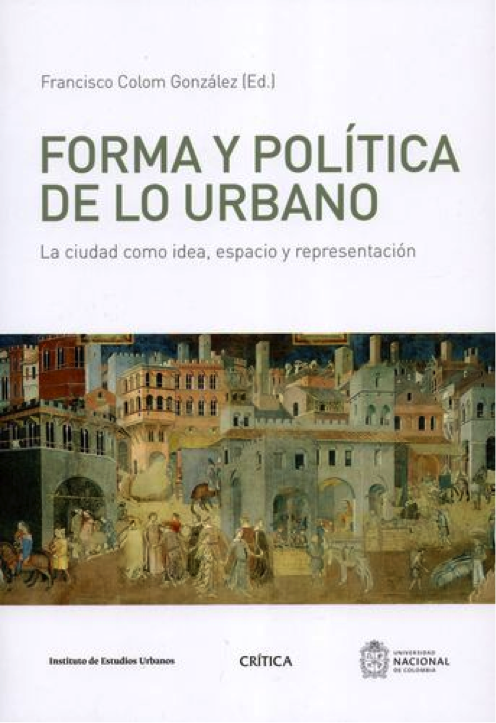
This edited book fouses on the city conceived as a human community, a space for social interaction, and a built environment created and transformed by its inhabitants throughout generations. The cities, however, are also recepients and bearers of cultural meanings produced by the relations between their citizens. In this sense, they appear as normatively mediated spaces, as the materialization of the values and interests that have contributed to the shaping of their image. Some cities were historically associated with ideals that are reflected in their design and internal structure, turning them into archives of memory that can be read as a text. However, for us to read a city, we need to know its history, its social and economic organization, its urban layout and architectural patrimony, and the narratives that recount how a city came to be what it is nowadays and how it is was seen by its coevals. In a series of chapters dealing with examples taken from the Mediterranean and the Latin American regions, this book invites us to explore the morphopolitics of the city, i.e. the connection bewtween social norms, the aesthetics of the built environment, and urban forms. The first part of the book offers a perspective of the political background of the urban fact in different historical contexts, from ancient Rome and the Islamic world to Renaissance Europe and colonial America. The second part of the book deals with the relations between urban representations and the social imaginaries recognizable in them.
3) Tomás Pérez Vejo: Repúblicas urbanas en una monarquía imperial. Imágenes de ciudades y orden político en la América virreinal. Bogotá, Grupo Planeta Colombia (Sello Crítica) - Universidad Nacional de Colombia, 2018, 210 pgs; ISBN: 978-958-42-7345-1
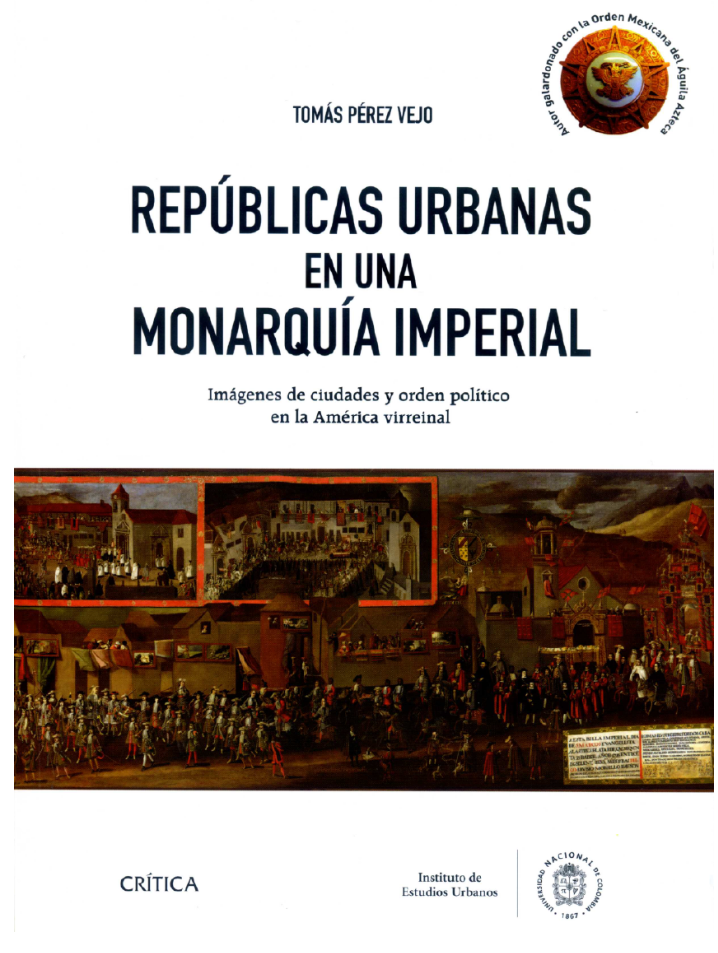
This book uses the images of urban landscapes in Spanish colonial America as a historical source. The type of information that these images provide is as rich and revealing as the information procured through written documents. Urban images are approached within this context not primarily as a work of art - in spite of the unquestionable aesthetic value of many of them - but as imaginary representations of the civic qualities of the city as they were seen by its dwellers; i.e. of the colonial city considered as civitas, and not only as urbs.
4) Eugenio Prieto Soto y Carlos A. Patiño Villa (eds.): Construccción de metrópolis. Identificación de procesos de planeación para un área metropolitana eficiente. Bogotá, Grupo Planeta Colombia - Crítica - Univ. Nacional de Colombia, 2018. ISBN: 978-95-84263865

En esta páginas se encuentra una radiografía que es, al mismo tiempo, un inventario sobre el estado de la asociatividad territorial en Colombia, sus potencialidades y desafíos, así como algunas lecciones aprendidas de una experiencia paradigmática para este país: la conformación del Área Metropolitana del Vallé de Aburrá (AMVA), donde su ubica la conurbación formada por Medellín y nueve municipios más. El lector encontrará aquí un estudio sobre las funciones que desempeñan las áreas metropolitanas y para quién lo hacen: sus habitantes y usuarios, cuyo derecho a una vida urbana digna se ve facilitado por la provisión de servicios a una mayor escala.
5) Francisco Colom González: Tristes patrias. Más allá del patritismo y el cosmopolitismo. Barcelona, Anthropos, 2019; 304 pgs. ISBN: 978-84-17556-16-7
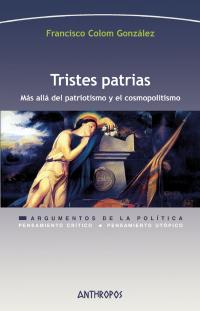
El nacionalismo se ha mantenido hasta nuestros días como una referencia política de primer orden en momentos de crisis. No nos hallamos, pues, ante un retorno del mismo sino frente a una nueva modulación del idioma político en que han venido expresándose las grandes transformaciones sociales desde la Revolución Francesa. La variedad de sus manifestaciones y contextos hace poco viable, sin embargo, una teoría general del nacionalismo. En su lugar podemos reconocer una serie de elementos comunes, como la centralidad de las emociones, la cambiante función de la etnicidad y la existencia de unos grupos favorecidos a la cabeza de sus movimientos. Este libro trata de caracterizar las condiciones generales del surgimiento del nacionalismo con el fin de hacer inteligibles los elementos ideológicos sobre los que se sustenta. Para ello combina la reconstrucción histórica con la reflexión política y se detiene en los componentes narratológicos, religiosos y filosóficos de sus relatos identitarios. Las experiencias europeas e iberoamericanas le sirven para ilustrar los análisis
6) Antonio Campillo: Un lugar en el mundo. La justicia espacial y el derecho a la ciudad. Madrid, Los Libros de la Catarata, 2019, 128 pgs.; ISBN: 978-84-9097-738-5.
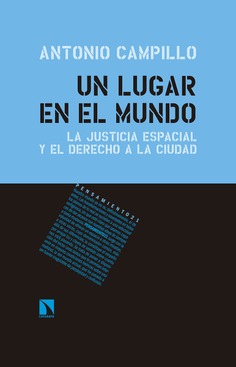
Aspirar a que el mundo sea un lugar hospitalario ha terminado por convertirse, con el devenir de la historia, en una de las últimas utopías pensables. Hemos llegado aquí como resultado de una calamidad organizada que se ha servido de los recursos de todo tipo alcanzados por la humanidad en su estadio más alto de desarrollo para excluir a amplios sectores de la población. la búsqueda de un lugar en el mundo en el que poder desarrollar un proyecto de vida tiene un hondo trasfondo moral y político que sale a la luz cuando consideramos la justicia social desde la perspectiva del espacio, como hace este libro.
7) Francisco Colom González (ed.): Narrating the cities. An approach to urban space through texts. Barcelona, Anthropos (forthcoming)
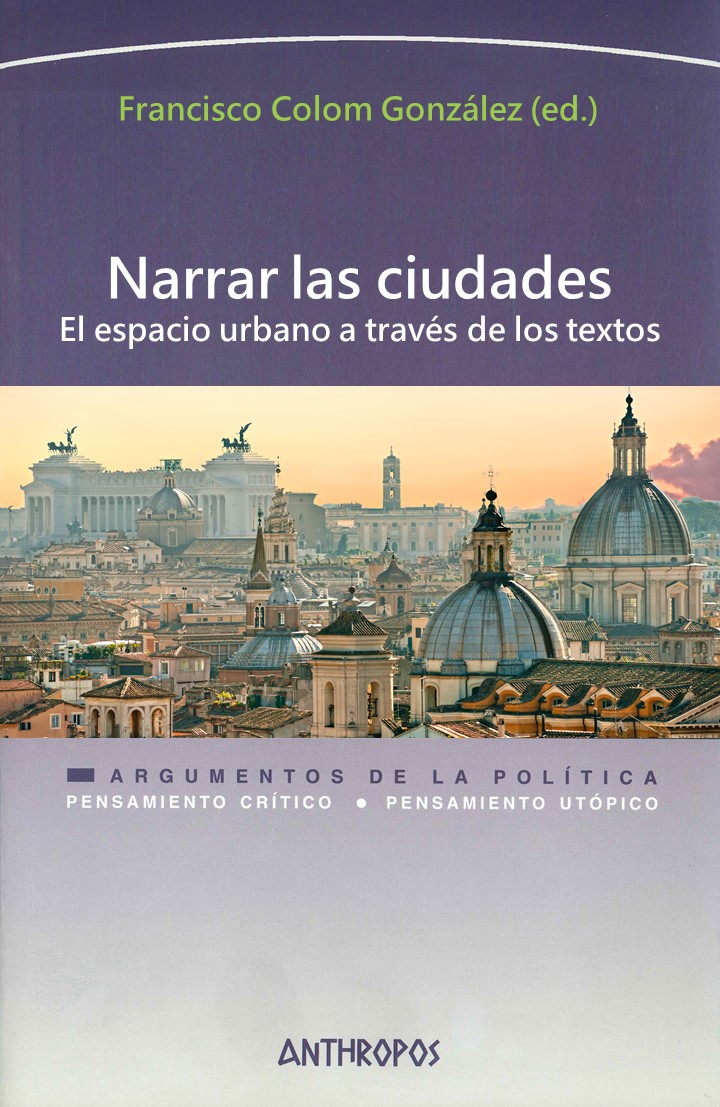
Cities are not timeless structures made out of buildings, spaces and monuments. They are artifacts constructed and inhabited by human beings and, as such, they are submitted to constant change. The manifold meanings inscribed in the urban body depend on the shifting interactions between its inhabitants with themselves and with the built environment. The urban morphology, however, does not speak by itself. The possibility of reading a city refers us to the hermeneutics of its past, its culture and social fabric, the history of its urban structure and the stories that tell how the city was seen and lived by its dwellers. A city, in this particular sense, appears before us as a normatively and narratively mediated space. It is a repository of the individual and collective memories of its inhabitants that is transmitted to us by means of their personal accounts, their creations and their legacy. In this book we explore a series of European, American and African cities through the eyes of several writers and artists, for whom such cities played a major role in their lives and works. Their experience of the city is used to frame their own creational activity and to better understand the space in which it took place.
* La huella republicana. Arte y poder en la Florencia de Maquiavelo
* José María Eça de Queirós y el antagonismo entre el campo y la ciudad
* Walter Benjamin: topografías de la ciudad de Berlín
* El París de Brassaï. La escenografía de la ciudad moderna
* El Argel de Albert Camus y la democracia de los bienes naturales
* Barranquilla: una ciudad en la imaginación y el recuerdo de Gabriel García Márquez
* 'Que caigan, uno a uno, despacito' Lectura mítico-política de Luanda por Pepetel
B- ARTICLES AND BOOK CHAPTERS:
1) Francisco Colom González: Max Weber y 'La ciudad'. Una interpretación a la luz de la experiencia hispanoamericana (Max Weber and The City. An interpretation form the Latin American perspective) in Álvaro Morcillo Laiz y Eduardo Weisz (eds.): Max Weber en Iberoamérica. Nuevas interpretaciones, estudios empíricos e interpretación. México, Fondo de Cultura Económica - CIDE, 2015, pp. 419-446. ISBN: 978-607-16-2130-
The essay by Max Weber that we know as The City is in fact a posthumous and incomplete text that was edited by his widow, Marianne Weber, and later included in his Complete Works. This circumstance, together with the changing subheadings added to the title and to the internal articulation of the text, have made us lose sight of its original meaning. In spite of recognizing the importance of cities at different places and moments in history, Weber saw in the European process of urbanization some extraordinary features. Medieval cities helped create specific forms of political socialization and pushed the emergence of an autonomous urban class with differentiated economic interests. Taking into account the importance of cities in the colonization of Spanish America and its territorial organization, Weber’s urban theory has an explanatory potential that has not been sufficiently explored in this field. Spanish American colonial cities projected on the New World a process of urbanization whose main social, political and cultural features had matured in Europe during the Middle Age and the Renaissance. This is why, although being dependent from the metropolis and marked by the ethnic division of labour, these colonial cities were in their own way western cities. In them we can recognize many of the characteristics described by Weber in his essay. A comparative glance at the urbanization process in the Old and in the New World from a Weberian perspective thus allows us to better understand some of the main characteristics of Spanish American social and political history and the similarities and differences with European history.
2) Francisco Colom González: La ciudad en la tradición política hispanoamericana, in TEORIA E CULTURA (Brasil), Número monográfico sobre: Cidade, Música, Tempo, Barroco, Vol. 8, Núm.2 (2013), pp. 9-29. ISSN: 2318-101X
Territoriality is not a mere physical dimension but a social production. From a political perspective, a territory is the result of a unique combination of space, history and power. The territoriality of the Spanish-speaking world has historically characterized for its intimate connection to the city as a social and political realm. This is a feature that became more conspicuous with the conquest and colonization of America. From the ancient Roman municipalities to the modern populist movements, the territorial nomos or political spatiality of Hispanic societies has been defined by their urban condition. This article offers a long-range view of the role of the cities in the Spanish American political tradition: their foundational rites and patterns, their colonial governance, their contribution to the formation of nations, and their role as an arena for the mass movements of the twentieth century.